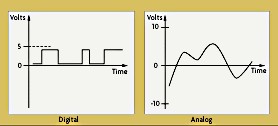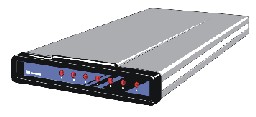CCNC/CCNC Module 1/Networks/Subsection Level CCNC Template19
(
: We need to make a decision on where this info gets covered-- here or in Module 7. Also, we should add Cable, Wireless, and Satellite broadband)
Analogue signals
Analogue signals are used on the PSTN as well as for normal AM and FM radio transmissions. An analogue signal is one which varies continuously as, for example, in ordinary speech. An analogue signal has a graphical form as shown in the following diagram.
Digital signals
Digital signals are used in ISDN and ADSL connections. Newer television and radio transmission techniques are also making using of digital technology.
Digital signals are two state signals corresponding to a switch which is on or off. The same two state signal can also represent TRUE and FALSE or 1 and 0.
Graphically a digital signal is represented as in the diagram above.
Modems
A modem or modulator-demodulator is a device connected between a computer and a telephone line. Its function is to convert the digital signals of the computer into a form suitable for transmission over a telephone line. It must also do the reverse and convert the telephone line signals into a form suitable for the computer. Note that the modem used to connect to an ISDN line is different to that used to connect to an analogue line.
Data transfer rates
Each 1 or 0 that is transferred is referred to as a bit. The speed of a data transfer is measured by the number of bits that can be transferred each second or bps (bits per second). This is also sometimes called the baud rate or bandwidth.
High speed lines have their speed measured in kbps or Mbps.
1 kbps = 1 024 bps (roughly 1 000 bps)
1 Mbps = 1 024 kbps = 1 048 576 bps (roughly 1 000 000 bps)
To put these figures in perspective, the maximum theoretically attainable speed with an analogue line is 56kbps. This figure is very seldom attained and the reality is usually substantially lower. ISDN lines operate at 64 kbps.

